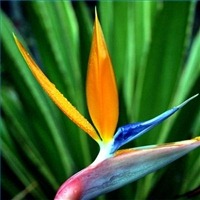Bird of Paradise (Strelitzia reginae) is an exotic plant that originated from South Africa. It can add beauty and charm to any garden. It shows well in a garden with mostly tropical plants, but it can also work well with any type of garden style. Add it in a flowerbed as a central focal point to add sophistication and drama to your garden.
- A Bird of Paradise Leaf
A bird of paradise looks like a colorful bird in flight. The blooms come in bright colors, usually a mixture of bright yellow and deep orange, with a tinge of red mixed with bluish purple at the center. The leaves resemble those of the banana plant, however, they are much thicker and firmer in comparison. The foliage is dark green in color and has rigid lines. The bird of paradise is trunkless, but can form in clumps. It can grow as high as 5 feet and in some cases even higher. The blooms are long lasting appearing in threes in each stalk.
Considerations
- Before planting bird of paradise in your garden, assess the location where you will put the plant. Bird of paradise does best with at least 4 hours of direct sunlight a day. Keeping the bird of paradise exposed to bright light all day is also necessary. They do best in temperatures of 68 to 72 degrees F during the day and 50 to 55 degrees F during the night. They are generally hardy at about 20 degrees F. You can plant bird of paradise directly into a mixture of potting soil, sand and peat moss. Adding bone meal into the soil mixture, especially when you plant them in huge pots or barrels, will keep the roots healthy. Keep in mind for the bird of paradise to bloom in pots they have to be crowded. Water regularly, at least once or twice a day during warmer weather. Ensure that the soil drains well, whether in pots or directly in the ground.
Time Frame
- Keep the soil evenly moist for the most part of the year, however, keep them dry from November through February. So, if you plant directly on the soil, be sure to plant on a raised bed or surround it with sand bags when you are expecting heavy rains and cover with plastic on stakes to prevent water seepage from the rain. Add balanced fertilizers (10-10-100 from March through September. Propagate the plants in early spring by dividing the rhizomes underground. Lift the plants from the pot before the new growth begins. Cut the rhizome with a sharp knife, ensuring that each division has a fan with roots attached to it. Transfer each division in smaller pots, water daily and keep in a dry location but with bright indirect light for about 8 weeks. During this time, the plant will recover and grow more roots to get ready for transplanting under direct bright sunlight. It takes 2 to 3 years for flowers to bloom on divided plants. If you plant bird of paradise in seed forms, it may take up to 10 years before the plant will bloom.
Types

Orange Bird of Paradise
There are several species of bird of paradise but the most popular types are the "Orange Bird of Paradise," "White Bird of Paradise," "Giant Bird of Paradise" and "Juncea Bird of Paradise." The "Orange Bird of Paradise" is the one most commonly referred to as the bird of paradise. There is also a variety called "Mandela’s Gold," which has bight yellow color with a blue tongue in the middle. The "White Bird of Paradise" grows as high as 18 feet tall and 5 to 6 feet wide. The flowers are white with light blue tongue and purple bract. The flowers are bigger than the "Orange Bird of Paradise." The "Giant Bird of Paradise" can grow as high as 30 feet with fan-like leaves and flowers just as the "White Bird of Paradise" except the bract has a red color. The "Juncea Bird of Paradise" is somewhat similar to the "Orange Bird of Paradise," except that the flowers are smaller and the leaves are spherical in shape.
Prevention/Solution

Ants on a Bird of Paradise
The most common problems seen with the Bird of Paradise are leaves that are drying out, leaves that are curling, leaves rotting at the base and insects. Leaves drying out may be due low humidity when the location is too dry. Cut the dry leaf and then place the plant in a location with higher humidity. When kept in a location that is too cold, the leaves tend to curl and turn black. Relocate the plant in a warmer location away from the window during colder months. Too much light would leave the leaves curl up even when they are green, so put them away from too much direct light during warmer months. When the base is rotting, it is an indication that the soil is not draining well. Ensure that the pot has enough drainage holes and that there is no blockage. The common insect problems seen are mealy bugs, scales, white flies, ants and aphids. Use ladybugs and insect sprays to get rid of them.


Deprecated: strpos(): Passing null to parameter #1 ($haystack) of type string is deprecated in /home/agriviek8Qv/agriviet.net/public_html/wp-includes/comment-template.php on line 2522